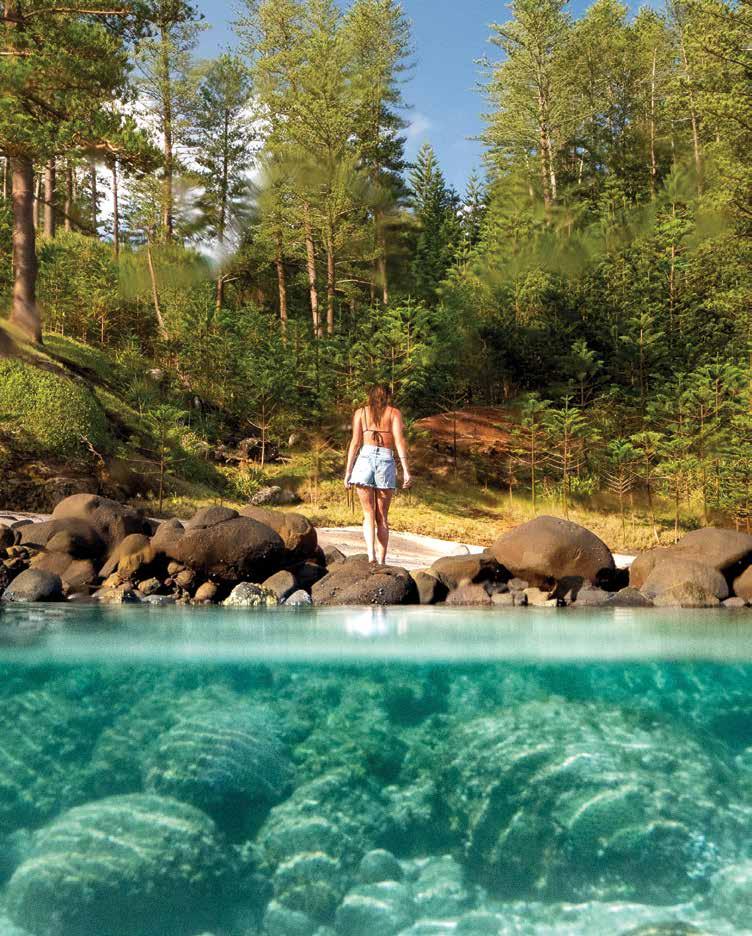
4 minute read
PARADISE FOUND - NORFOLK ISLAND
Images courtesy of Norfolk Island Tourism
As Kiwis eagerly anticipate the expansion of our travel bubble to Pacific destinations, it’s time to start planning for your great escape: and it’s time to take a look at Norfolk Island. It’s not far away, but it’s far and away the best place to get away from it all and experience something truly different.
Advertisement
Norfolk Island is synonymous with Bounty mutineers and convicts, but the island’s history is much broader than that.

IT’S JUST TWO HOURS and twenty minutes from Auckland on an Air Chathams direct flight, but Norfolk Island has it all. Great food, warm hospitality, amazing scenery and an intriguing history and culture that can be found nowhere else. It’s no wonder Kiwis in the know have been visiting Norfolk Island for years.
To many, Norfolk Island is synonymous with Bounty mutineers and convicts, but the island’s history is much broader than that. It was home to Polynesian seafarers between the 13 th and 15 th centuries, and it is a mystery to this day as to why these settlements were abandoned. In 1788 the first British colony was established – just five weeks after the founding of Sydney – as the Empire was in dire need of ships spars and masts, rope and sail cloth. Sydney was also in dire need of food: the arid Australian soil was no match for the fertile Norfolk ground and so the island was to sustain not just the Royal Navy but Sydney itself.
Shipwrecks and bad luck meant this all came to nought however: the much-needed rope and timber turned out to be unsuitable and in 1814 the colony was abandoned, to be replaced in 1825 by the notorious penal colony that many people associate with the island today. In fact, this second settlement – though duly infamous – was relatively short-lived, and in 1856 Norfolk was handed over to Pitcairn Islanders, the descendants of the Bounty mutineers, who were a hardy, industrious and self-sufficient bunch that set about making the island the success story it is today.

ABOUT 40% OF THE ISLAND’S POPULATION of around 1,700 is now made up of descendants of Pitcairners, with the remainder being mostly settlers from Australia and New Zealand, and it is this rich cultural history that makes the island unique. Kingston, where the old convict quarters remain, and the museum, which charts the history of the island and the brave souls that navigated to it, are glimpses into a tumultuous past, but it is a past that is celebrated as part of the journey of modern Norfolk Island.
And modern Norfolk Island is a joy. Blessed with all the bounty of the ocean and a fertile environment, no one does real food like Norfolk Islanders. Super fresh seafood like kingfish and yellow fin tuna, succulent local beef, pork and produce are delivered to the island’s eateries daily; there are no ‘food miles’ on Norfolk, there are ‘food metres’, and this is all brought together in a unique and distinctively Norfolk mix of the old English recipes inherited from the Bounty mutineers combined with the traditions of their Tahitian wives and modern fusion flavours: savoury banana fritters with pan-fried fish, grass fed local fillet steaks, banana dumplings cooked in coconut milk known locally as ‘mudda’, artisan cheeses and honey just to name a few. Everything is fresh, rich and naturally grown; there is a reason that local fresh cream is known as ‘Norfolk Island gravy’. This really is a foodie destination with a difference.
But the island is also blessed with some stunning scenery and flora and fauna. Its geographic location means it has a natural environment as unique as its history, with numerous species only to be found on the island. But to be honest most visitors prefer the golden sands and shimmering blue waters to the bird watching or turtle spotting. Many Kiwis associate Norfolk Island with the pine that shares its name, which conjures a vision of windswept rolling hills, when nothing could be further from the truth; instead Norfolk is subtropical, home to guava and bananas and a native passionfruit, coral formations and all manner of tropical fish. And like New Zealand, it is not home to any poisonous creepy crawlies or sea monsters.
ALL THESE THINGS – short flight times, historical interest and the safe, laid back lifestyle -- have traditionally made Norfolk Island ideal for, how shall we say it, more mature travellers. And while that remains true, a new generation of Kiwis are discovering the off-the-beaten-track pleasure of this little piece of paradise that is so close to home – because it really does have it all. While the less adventurous flock to the usual locations for package tours and cocktails with paper parasols, when you’re planning your first foray outside of Aotearoa make sure you think about coming and experiencing Norfolk Island, it’s history, it’s hospitality, and its authenticity. It’s not just something different, it’s something better.


